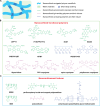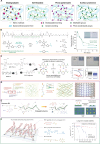Molecularly Designed and Nanoconfined Polymer Electronic Materials for Skin-like Electronics
- PMID: 39735315
- PMCID: PMC11672543
- DOI: 10.1021/acscentsci.4c01541
Molecularly Designed and Nanoconfined Polymer Electronic Materials for Skin-like Electronics
Abstract
Stretchable electronics have seen substantial development in skin-like mechanical properties and functionality thanks to the advancements made in intrinsically stretchable polymer electronic materials. Nanoscale phase separation of polymer materials within an elastic matrix to form one-dimensional nanostructures, namely nanoconfinement, effectively reduces conformational disorders that have long impeded charge transport properties of conjugated polymers. Nanoconfinement results in enhanced charge transport and the addition of skin-like properties. In this Outlook, we highlight the current understanding of structure-property relationships for intrinsically stretchable electronic materials with a focus on the nanoconfinement strategy as a promising approach to incorporate skin-like properties and other functionalities without compromising charge transport. We outline emerging directions and challenges for intrinsically stretchable electronic materials with the aim of constructing skin-like electronic systems.
© 2024 The Authors. Published by American Chemical Society.
Conflict of interest statement
The authors declare no competing financial interest.
Figures




Similar articles
-
Skin electronics from scalable fabrication of an intrinsically stretchable transistor array.Nature. 2018 Mar 1;555(7694):83-88. doi: 10.1038/nature25494. Epub 2018 Feb 19. Nature. 2018. PMID: 29466334
-
Molecular Design of Stretchable Polymer Semiconductors: Current Progress and Future Directions.J Am Chem Soc. 2022 Mar 23;144(11):4699-4715. doi: 10.1021/jacs.2c00072. Epub 2022 Mar 9. J Am Chem Soc. 2022. PMID: 35262336 Review.
-
Skin-Inspired Electronics: An Emerging Paradigm.Acc Chem Res. 2018 May 15;51(5):1033-1045. doi: 10.1021/acs.accounts.8b00015. Epub 2018 Apr 25. Acc Chem Res. 2018. PMID: 29693379 Review.
-
Intrinsically Stretchable and Healable Polymer Semiconductors.Adv Sci (Weinh). 2024 Feb;11(8):e2305800. doi: 10.1002/advs.202305800. Epub 2023 Dec 19. Adv Sci (Weinh). 2024. PMID: 38115748 Free PMC article. Review.
-
High-speed and large-scale intrinsically stretchable integrated circuits.Nature. 2024 Mar;627(8003):313-320. doi: 10.1038/s41586-024-07096-7. Epub 2024 Mar 13. Nature. 2024. PMID: 38480964
References
-
- Sugiyama M.; Uemura T.; Kondo M.; Akiyama M.; Namba N.; Yoshimoto S.; Noda Y.; Araki T.; Sekitani T. An Ultraflexible Organic Differential Amplifier for Recording Electrocardiograms. Nat. Electron. 2019, 2 (8), 351–360. 10.1038/s41928-019-0283-5. - DOI
Publication types
LinkOut - more resources
Full Text Sources
